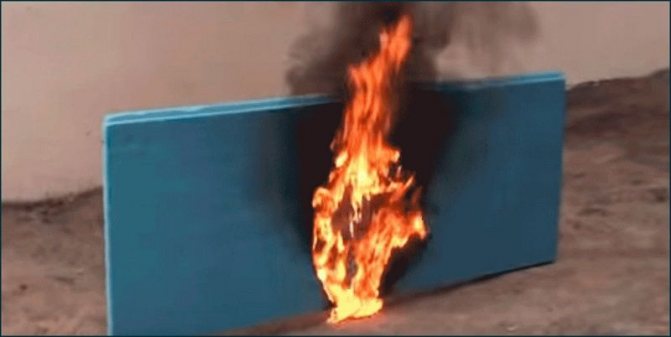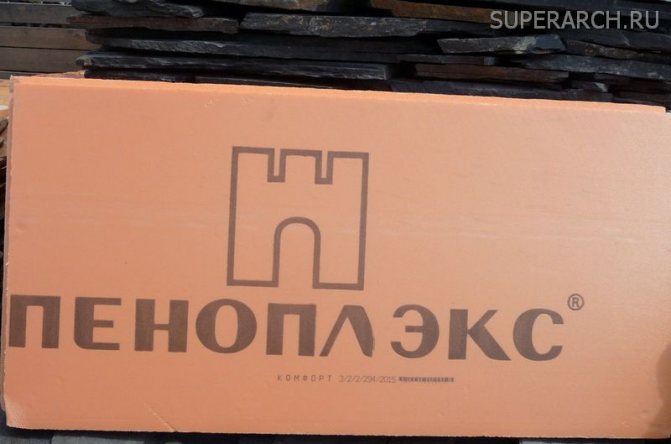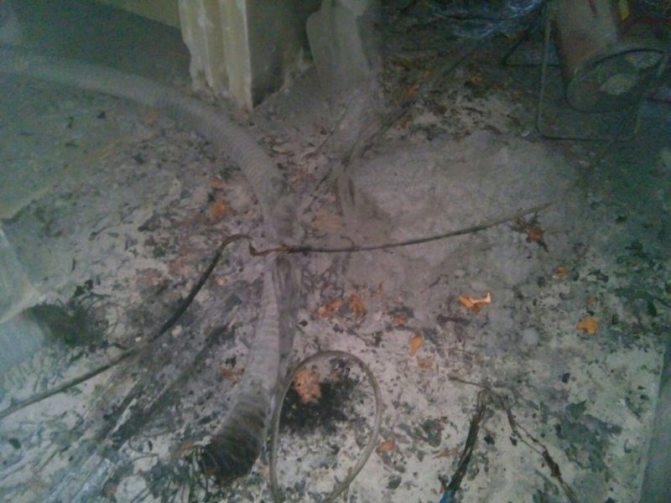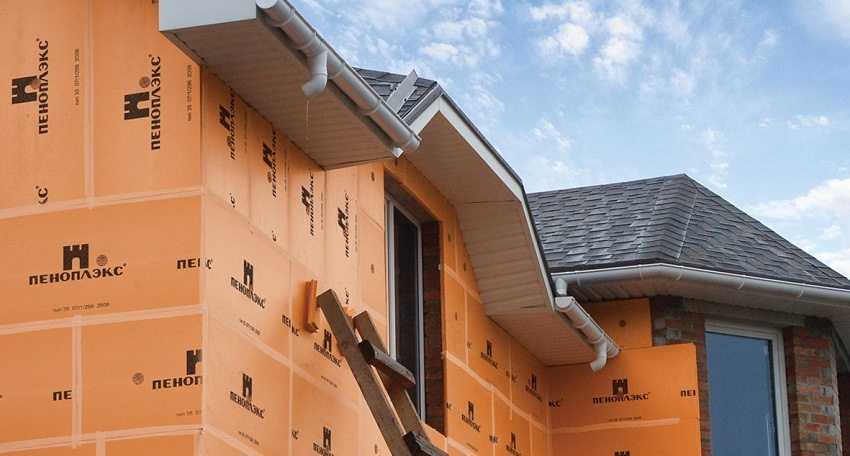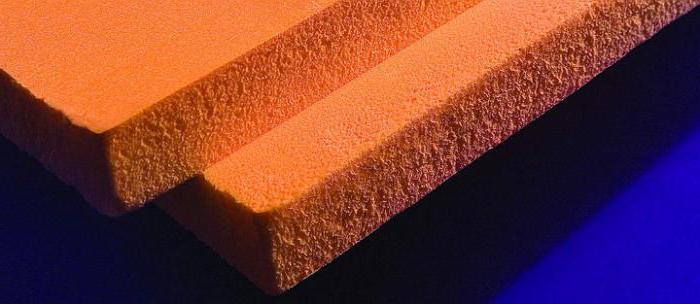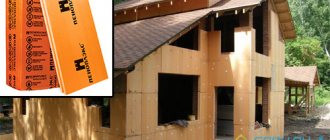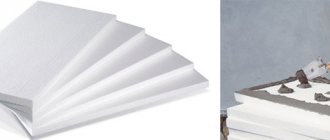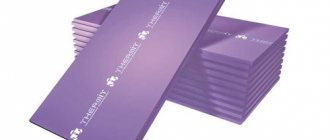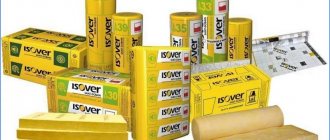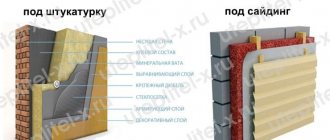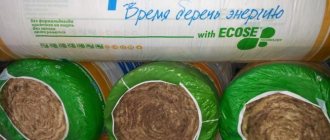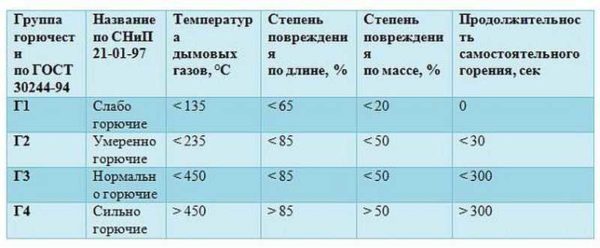
Flammability is not the best characteristic


Plates for insulation Penoplex are of different thicknesses and densities
As you can see, in terms of temperature indicators, any type of Penoplex can be used in any part of the country - from the south to the north. Moreover, if it is left to "winter" in an unprotected form, nothing will happen to the material. This is not the merit of Penoplex, but the general property of extruded polystyrene foam.
What distinguishes the different types
The manufacturer divided the types of Penoplex into areas of use. Their properties are optimal for a specific application. For example, the increased density of EPS, required under the screed, will not be needed when it is installed on the base. Taking into account that the price differs significantly, it makes no sense to use the “Foundation” brand for other purposes. But the difference in locks, all other things being equal, can be neglected. Here we are talking about ease of installation. Although, this is also important.
Investigating the flammability of extruded polystyrene foam
When choosing material in order to insulate a house, people are guided by different principles. For some, the price is important, for others - ease of use, while others pay close attention to parameters such as environmental friendliness and fire safety. In this regard, what can you tell about extruded polystyrene foam - is it slightly flammable or is it dangerous in case of fire? You can find many different opinions about the flammability of extruded polystyrene foam, and sometimes they are even opposite. Let's try to figure out what is the matter here.
Flammability class of extruded polystyrene foam
Speaking about the flammability of extruded (extruded) polystyrene foam, it should be borne in mind that various grades of it are produced. With general similar thermal insulation characteristics, they, however, differ in fire hazard class. Thus, opinions that extruded polystyrene foam is slightly flammable or non-flammable at all may also have a right to exist. But is it really so?
- G1 - slightly flammable
- G3 - normally flammable
- G4 - highly flammable
- NG - non-flammable
G2 - moderately flammable
It is only natural that sellers seeking to advertise a product claim fire safety. They claim that they do not sell flammable extruded polystyrene foam, but a material that is quite fire resistant. If you come across such an offer - do not believe it! You are either misled, or you yourself confused: there is no non-combustible extruded polystyrene foam - the price of such a statement is zero. Another thing is that it can belong to class G1 - low-flammable materials. Is the difference small? Sellers think that way. By the way, do not confuse it with simply non-flammable polystyrene foam (not extruded), that is, foam.
What about extruded polystyrene foam - is it dangerous when it burns? Let's take as an example the products that occupy half of the entire thermal insulation market in Russia. Until recently, insulation of this brand was attributed to hazard classes G3 and G4, indicating also the harmful substances that extruded polystyrene foam emits during combustion. Relatively recently, the products received a new fire certificate, in which class G1 was assigned to some of its types (in particular, Penoplex-35).To obtain low-flammable extruded polystyrene foam, a flame retardant additive was introduced into its composition, which significantly increased the resistance of the material to fire. According to the company's specialists, unlike many other organic materials, when burning, such extruded polystyrene foam emits no more harmful substances than ordinary wood - only carbon monoxide and carbon dioxide.
However, consumers are far from always inclined to believe the manufacturer and are certainly not going to heat the stoves with penoplex to check this statement. Many are convinced that this study, conducted by the Independent Testing Center for Fire Safety of the City of St. Petersburg, is not entirely true, and are more inclined to trust government agencies. And they just assert that non-combustible extruded polystyrene foam does not exist in nature, and assign it flammability classes G3 and G4.
Is penoplex amenable to combustion or not?
Official manufacturers do not give any information about absolute non-flammability. There is only mention of an independent study, according to which penoplex began to be attributed to the G1 class. But there are no such records in official government documents. This is what causes controversy, some consumers are sure that an independent examination was interested in the result, so the statement that penoplex does not emit harmful substances is simply absurd. But based on the statements of both parties, we can conclude that opponents of the incombustibility of polystyrene are simply unfamiliar with the properties of a fire retardant. Of course, such substances will not be able to prevent combustion, but they will not allow the material to burn out. How can this be explained? It's simple. Under the direct influence of the flame, the penoplex will ignite, but as soon as the fire stops acting on it, it immediately goes out. It is based on these characteristics that the foam is called non-combustible, since by itself it can cause a fire. If we evaluate the claims that penoplex emits no more harmful substances than wood, it looks controversial. Since extruded polystyrene foam is a synthetic material, in addition to carbon monoxide, it emits other chemical compounds that can cause pulmonary edema, severe poisoning and even suffocation in a person.
Does Penoplex burn and not?
It is worth mentioning that on the official websites of Penoplex information that extruded polystyrene foam is not combustible cannot be found. There are only a few words about that very independent research and compliance with GOST. But it is precisely this moment that raises questions. In addition, not all consumers are convinced that the combustion products of extruded polystyrene foam are so harmless. It is possible that the distrustful simply did not have to meet with material treated with flame retardants. These substances prevent combustion (but not fire). That is, when exposed to a high temperature flame, the insulation will light up, but will quickly go out as soon as it comes out from under its influence. Apparently, this is why the processed extruded polystyrene foam is unofficially called non-combustible - by itself it cannot cause a fire and does not interfere with its extinguishing.
As for the combustion products of the same penoplex, it is still not necessary to compare with what is released when burning a tree. Say what you like, but this is an artificial product. During combustion, it emits not only CO (carbon dioxide) and water vapor, but also soot and hydrogen chloride, the inhalation of which is fraught with severe suffocation and pulmonary edema.
Let's summarize everything we've learned about extruded polystyrene foam - is it non-flammable, is it safe? how does its price differ from the usual one?
- The flammability of conventional extruded polystyrene foam is usually in the G3 and G4 classes
- Special flame retardant additives are able to raise the flammability class of the heat insulator to G1
- It can be called non-flammable only conditionally, meaning its high resistance to fire
- The products emitted by extruded polystyrene foam during combustion are quite dangerous.
The price for "conditionally non-combustible" extruded polystyrene foam is not much different from the usual one. This is also due to the fact that, in principle, its density is higher - class G1 is assigned to penoplex with a density of 35, while penoplex-31 remains a fire hazardous material with class G4. A cubic meter of low-combustible Penoplex-35 costs about 4200-4300 rubles. Other manufacturers of extruded polystyrene foam - Technonikol, Ursa, etc., also produce products in the processing of which fire retardants are used.
It is worth remembering that fire safety depends not only on the material itself, but also on the correctness of its application. Highly flammable penoplex is intended for insulation of foundations, basements, floors, and in no case facades and walls. It is the fire hazard that is one of the characteristics that hinder the even wider use of this heat insulator. However, this problem is being solved by the manufacturer, and it is possible that soon the use of non-combustible extruded polystyrene foam will become the norm in construction.
Varieties of Penoplex
Penoplex has specially designed brands for insulation of walls, facades, plinths and other structures. The grades meet the increased requirements for adhesion of thermal insulation boards and substrates. Penoplex is often used for thermal insulation of walls of balconies and loggias.
Penoplex 45 - able to withstand the most impressive weight
It is noteworthy that this material can be used to insulate not only roofs, but also roads, railways and runways. It is the most durable in the entire list. Its main advantage is that it does not lose its qualities throughout its rather long service life.
By the way, insulation of roads for any purpose protects them from swelling after freezing. For example, if in spring and summer the soil accumulates moisture in itself, in winter a road laid on this soil can crack from an excess of water. Thanks to the insulation, the soil will not freeze.
Penoplex Comfort - universal heat insulator
The material (formerly referred to as Penoplex 31C) is truly multi-purpose. They can insulate a country house, loggia or roof. If there is a pool or you built it on a suburban area or, then Penoplex Comfort will be an excellent option for their walls.
Versatility is mainly due to the fact that the material is able to withstand not only high levels of humidity, but also high temperatures. Penoplex Comfort is a fully multifunctional heat insulator that is suitable for most types of insulation work.
Penoplex Roofing - what you need for a roof
Perhaps it is worth mentioning that in the past this heat insulator was called Penoplex 35. Suitable for any kind of roof insulation. In the construction industry these days, a "lightweight" roof is very often used. It is extremely important to take care of its reliability, strength and durability.
A similar problem is solved in the case of repair work on a flat roof, at the base of which there are profiled metal sheets. In this case, the best solution would be to use a refractory material called Penoplex Proof. Often it is he who is used to insulate a flat roof. Penoplex Proof is suitable for attaching attics and ventilated roofs.
Nowadays, non-standard inversion roofs are becoming more and more famous. Due to the lack of free space in densely populated cities, such roofs provide this space where you can make your own private resting corner or organize, for example, a small garden with flowers. Based on the fact that it can easily withstand heavy loads, even a transport parking can be equipped on such roofs.
Penoplex Wall - inside and outside
This is a new name. Earlier it was called Penoplex 31 with fire retardants. However, the very essence has not changed much.Insulation of facades, walls, partitions of houses - this material is ideal for such work.
It is noteworthy that it is required to insulate the wall from the inside only if, for one reason or another, this process does not come out from the outside. Or, if in the process of express repair it is much more convenient to cover the walls with a heat insulator from the inside. Penoplex Wall is an excellent and convenient material that is not difficult to work with.
If we talk about using it outside, this heat insulator proved itself very well during the well laying of the walls. In comparison with the usual brick walls, these walls are much thinner, but they are not less reliable. As well as the ability to keep warm.
The Penoplex Stena brand can be used in the process of creating facades treated with plaster. Since, which is now in great demand, it boasts a large selection of colors and varieties, such a move will give the house an individual originality.
What is the difference between Penoplex Foundation
The name itself (which sounded somewhat earlier like Penoplex 35 without a fire retardant) makes the buyer understand that this insulation option is ideal for the underground part of the building. Its characteristics are endowed with a high degree of strength and are quite capable of withstanding heavy loads.
The “Foundation” type of thermal insulation proposal is very suitable for or floors in the house - that is, where there is no need for a high level of fire resistance. Some structures with a protective coating can be insulated with a “foundation”. For example, it can be a screed made of sand and cement.
The flooring of the Penoplex Foundation slabs will help in a short time to solve the tasks that are directly related to the creation of the foundation of the house and the equipment of the basement. A high level of protection against moisture, groundwater abstraction is not all the advantages of the material described. Additionally, it allows you to lower the groundwater pressure on the basement of the building.
Let's talk about the disadvantages
The disadvantages are predictable, to a greater extent apply to all materials from extruded polystyrene foam. The disadvantages are not significant and there are not many of them:
- bad;
- fire risks, poor fire safety;
- does not impede the raids of rodents and ants
- Cost of a mid-range product - Styrofoam is cheaper
Noting the risks of attacks by insects and rodents that spoil the insulation, we note that the disadvantage concerns any kind of thermal insulation material. Reviews on the use of the product found on thematic forums indicate efficiency, functionality and economy. If you have your own negative experience with the material, please add the deficiencies in the review in the comments block.
Penolex is a type of thermal insulation material, which is extruded polystyrene foam. Most people, when choosing a suitable insulation for the house, are guided by various characteristics of the material. Many are interested in the low price, some prefer ease of installation, and only a small part think about environmentally friendly safety and resistance to fire. What are the characteristics of penoplex, does it lend itself to combustion or is it absolutely non-flammable? It is strange, but there are a lot of opinions about this indicator, so it is worthwhile to understand in more detail the fire safety of penoplex.
Technical characteristics of the material penoplex
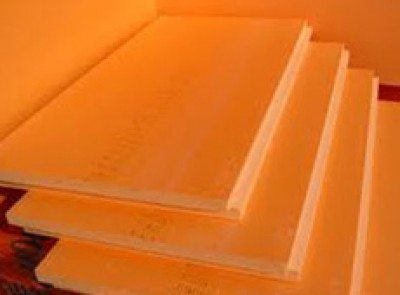

Among the extensive line of heat-insulating materials, one of the first places is occupied by penoplex. Most of those who like to do something with their own hands are attracted by the low price of the slabs of this insulation and the ability to mount them on their own without resorting to the help of workers.
This allows you to significantly save on the insulation of private and country houses.Due to the low thermal conductivity of the foam, the finished structures are quite warm.
Material advantages
Consumers refer to the advantages of Penoplex, first of all, a low degree of thermal conductivity. According to this indicator, such slabs surpass even mineral wool, which is very popular, for example, among private developers. Also, the advantage of "Penoplex" is its low weight. It is very easy to transport such plates. This material is distinguished by its ease of installation. Attach it to insulated surfaces with glue of a special composition. In some cases, slabs of this material can be additionally attached to walls, partitions or, for example, the ceiling using plastic dowels, fungi. Also, this material is easy to cut.
Another advantage of "Penoplex", in comparison with the same mineral wool, is that it is not afraid of water at all. When moistened, this material does not lose its heat-retaining qualities and does not begin to deteriorate.
Another undoubted advantage of "Penoplex" is the ability to withstand significant loads. Dense slabs of this material are often used to insulate floors, for example, under a screed. Such sheets are somewhat more expensive than mineral wool, but still the price for them is not too high.
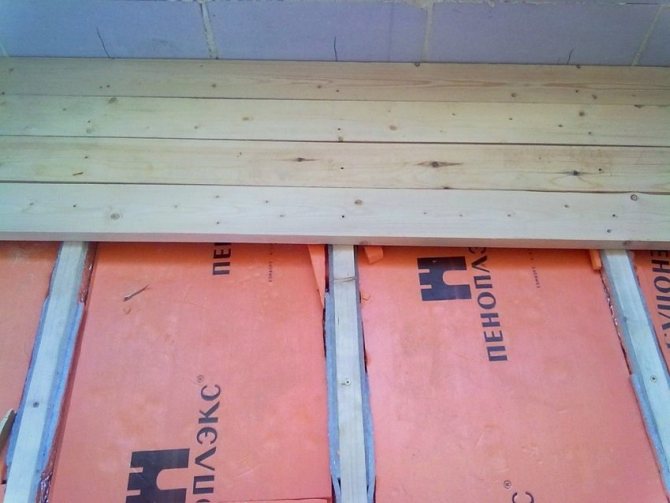

What is Extruded Polystyrene Foam
The complex technical name of the insulation alarms many who prefer to use only environmentally friendly, low-combustible materials in the insulation of their homes. Modern technologies make it possible not to use freons as a foaming agent. Therefore, only CO2 or freons are now used for expanded polystyrene granules. So we may well call it environmentally friendly.
The material has a number of characteristics that make it very attractive for private and low-rise buildings, as well as for use on an industrial scale.
- The insulation has no biological component, therefore it does not rot or decompose. These properties make it durable (service life ≥ 50 years).
- Eco-friendly insulation. Moreover, we can even talk about the environmental friendliness of its production.
- Perfectly proved itself in the systems "warm floor". The entire structure of the "warm floor" is mounted on top of the 35 penoplex. A low coefficient of thermal conductivity will effectively save heat, due to which the cost of heating a house or apartment is significantly reduced.
- Wide range of applications. The insulation can be used both in a country house and at an airfield.
Penoplex technical characteristics are presented in the table below.


Where can Penoplex be used?
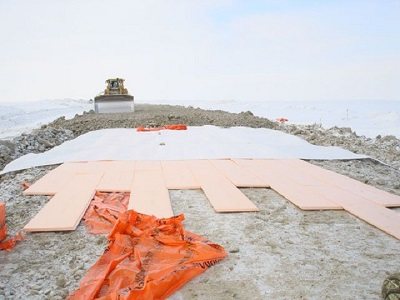

Extruded polystyrene foam has found its application in various fields, both in residential construction and repair, and in industrial.
Its technical characteristics vary widely in terms of such indicators as plate thickness, combustibility, strength, which allows them to insulate both runways at airfields (100 mm thick plates) and house walls, foundations, etc.
Penoplex markings
There are several penoplex markings, such as M35, M45 and others. It should be noted that this is an old marking. They are currently not in production.
- Modern markings - 31C, 35, 45. Penoplex 31C has weak technical characteristics for compression, therefore it is used mainly for insulation of pipes or containers.
- Penoplex 35 is versatile, quite durable, so it can be used to insulate both pipes and walls of buildings, foundations, and can be used in a screed on the floor. The characteristics of this brand have excellent thermal insulation qualities.
- Penoplex 45 can be successfully used for insulating runways at airfields, for insulating deep foundations, floors in industrial premises. It is indispensable for the arrangement of the road surface.Its density, higher than that of 35, perfectly withstands loads, and the almost complete absence of water absorption does not allow the canvas to swell after heavy showers and subsequent frosts. For 45, there are no prohibitions for use on a production scale.
Penoplex properties and features of its manufacture
The very first extrusion equipment appeared in America more than fifty years ago. During production, polystyrene granules are affected by increased pressure and hot temperatures. The process is accelerated by a special foaming agent.
Thus, an extremely fluffy mass is obtained, similar to whipped cream or thick sour cream. It is squeezed out of the apparatus. After a certain period of time, the gas involved in foaming is eroded, and oxygen enters the vacated cells. A large air mass is formed inside, and we know from schoolchildren: a layer of air at rest is the best insulation.
Thanks to the extrusion process, the created material forms a structure with fine pores. And each of these absolutely identical pores is completely isolated. Their size does not exceed 0.2 mm, they are evenly spaced inside. Thanks to this, the insulation is durable.
Penoplex insulation brands are available with different characteristics, with a wide range of applications. Slabs Penoplex produce thermal insulation of foundations and plinths. Insulate layered masonry and plaster façade. The manufacturer pays special attention to the roof, there are Penoplex brands for inversion, traditional and exploited roofs. Floors have not been forgotten, including "warm" options.
What is Penoplex good for?
The properties of penoplex are varied, which is very convenient for do-it-yourself work, in the country or in a private house.
- Ease of installation and low weight make it easy to mount this insulation without the help of specialists.
- Such characteristics of foam as a low coefficient of thermal conductivity, density and others allow it to be used not only for external insulation, but also for thermal insulation of floors at the construction stage. Plates with a density of 45, with a thickness of 50 mm and more, can easily withstand a concrete screed, serving in the future as an excellent service. You will always have a relatively warm floor.
- Penoplex plates, 20 mm, 30 mm, 50 mm thick and higher, will make the walls, floor and roof warmer. Now you don't have to worry about buying warm slippers or a sweater. Penoplex will reliably protect you from bad weather.
- Such quality of penoplex as vapor permeability baffles many. After all, we are used to counting and hearing from sellers in hardware stores that the walls (floor, roof) must breathe. But think about it. Through these micropores, our house (wood or brick) not only breathes, but also loses heat. Using Penoplex insulation, simply organize high-quality ventilation in your room by equipping, for example, a micro-ventilation system and supplying an extractor hood. Thus, you will create a healthy microclimate in your home.
A little about the flammability of penoplex
Most homebrew builders believe that penoplex is no different from polystyrene, except for its structure. Its properties such as flammability and water absorption are equated to the properties of foam. This is not true. Now, both non-combustible foam and completely combustible foam are produced. Therefore, trusting rumors that penoplex burns strongly, or not, is your decision. However, we note that penoplex is deprived of the possibility of spontaneous combustion. In the presence of a source of constant fire, it only melts, with the release of carbon monoxide (CO) and carbon dioxide (CO2) gases. If the fire is extinguished immediately, even smoldering will not be observed. Therefore, when choosing between modern foam and foam, give preference to the second material.
Important... Ordinary foam, which you can easily find in a box with some household appliances, burns perfectly.But it is foolish to think that there is no difference between it and construction foam. None of the varieties of penoplex burns, but only melts in the presence of an open flame source.
Application area
The main area of application of foam in construction is thermal insulation. If you use it outside, then it would be illogical to talk about its harm to health.
Strength and low water absorption allows you to use penoplex for.
Roofs are also insulated with this material.
It is difficult to give objective advice on this matter, since there are different points on this subject (the limitation may be due to the fact that the roofs get very hot). There is only one recommendation - to follow the insulation technology.
The foundation can be insulated from the outside and from the inside. If you insulate the outside, then do not be surprised that the material collapses over time. This is not related to its durability under normal conditions, since existence underground in a changing climate is detrimental to this material.
Russian brands of penoplex
Russian craftsmen did not bypass the production of such a popular insulation as penoplex. In our market there are such brands as Technoplex from the TechnoNIKOL corporation and Polispen. Let's consider each of them in detail.
Technoplex
Technoplex is designed specifically for private construction, as well as for the arrangement of a warm floor system. In production, nanotechnology is used - graphite particles that enhance the effect of low thermal conductivity and further increase the strength of the material plates. Plates of this insulation are light silver and meet all standards for the production of foam.
Insulation Technoplex is produced with plates with different parameters. Even individual sizes are possible, if requested by the customer. The thickness of the slabs is different - 20, 30, 40, 50 and 100 mm. All plates, except for 20, have a special edge, which, during installation, excludes the appearance of cold bridges. Technoplex boards can be stored both indoors and outdoors, provided that the original packaging is intact. After installation, the surface of the Technoplex insulation must be insulated from atmospheric influences.
Polispen
LLC "Polispen" successfully produces extruded polystyrene foam under the brand of the same name. There are three types of foam boards in production, differing from each other in characteristics - compression density, thermal conductivity coefficient and flammability. These are the brands:
- "Polispen Standard"
- "Polispen 35"
- "Polispen 45"
The numbers 35 and 45 mean the density of the material, respectively 35 kg / m3 and 45 kg / m3. During production, special substances are used that reduce flammability - fire retardants.
Plates "Polispen Standard" are used where their combustible component is the least important - for internal floor insulation, in foundations. Plates with a density of 35 are used to insulate fences and load-bearing structures of buildings. Plates "Polispen" with a density of 45 are used in the arrangement of road surfaces, as well as structures that carry excessive loads.
So, we have an excellent thermal insulation material made in the form of plates of various thicknesses - 20, 30, 40, 50, 60, 80 and 100 mm (depending on the manufacturer, the thickness range may vary, the standard range is 20/30/40/50 / 100), impregnated to varying degrees with fire retardants (the price of non-combustible material is more expensive), different density and compressive strength, used both in private housing construction and in industry. Russian penoplex brands such as Tenoplex and Polispen have proven themselves in the Russian market.
Method of obtaining
On the websites of supplier companies, there are often similar names: expanded polystyrene (sometimes extruded), polystyrene, polystyrene foam, polyurethane foam and some others. It is useful to understand what is at stake in each case.
Foams are a class of polymers (plastics) in which cells with air are contained between the chains of the organic matrix. If the microcavities are connected to each other, the product is called a porous plastic.
Foams are produced by mixing large polymer molecules or medium oligomer molecules with solid blowing agents, low-boiling liquids or an inert gas.
There are technologies in which gas is formed during a chemical reaction of organic raw materials. The foamed product is shaped by cooling or special curing techniques.
Expanded polystyrene is the result of foaming a styrene suspension with pentane or isopentane. The primary product is in the form of granules. After heating, the granular particles are foamed and then sintered.
There is a modification of polystyrene foam obtained by polymerization of the monomer. The resulting polymer is mixed with pore-forming additives. The resulting mixture is passed through an extruder.
The result is a high density expanded styrene polymer. Extruded polystyrene foam, often called polystyrene foam. It is a product with good thermal insulation properties. It can be used to insulate houses even in the Far North.
Among the foamed products, polyurethane foam, which is also known as foam rubber, is very popular. It is obtained by foaming a liquid reaction mixture of monomers with the addition of organosilicon components, foaming agents (water or freon), substances of high surface activity.
By varying the process conditions, polymers of different hardness can be obtained. They have conditionally non-flammable properties. Foamed polyurethane products with a reinforced matrix are used as insulation.
How is it produced
The first plant for the production of extruded polystyrene foam appeared in the United States more than half a century ago. In the manufacture of this material, special chemical foaming agents are used - porophores. The chamber of special equipment gets very hot at first. Then polystyrene granules are fed into it. After melting them, porophores are added to the mixture. As a result, the polystyrene expands and expands significantly.


You will be interested: How dangerous is the new coronavirus?


The resulting mass, which looks like whipped cream, is then fed into a conveyor belt in an even layer of a certain thickness and cut into plates of the required dimensions. As porophores in the manufacture of expanded polystyrene, for example, substances such as ground perlite, citric acid, sodium bicarbonate can be used.
All types of such material are produced using this technology, including Penoplex, Extrol, Technoplex, etc. During the production of such materials, various ingredients can be added to them to change, for example, characteristics such as strength, density, flammability. Penoplex, which includes such components, has the best technical and operational characteristics.
Ignition and smoke production
Comparative characteristics of different brands of expanded polystyrene
Many foamed polymers are referred to by manufacturers as non-flammable. Strictly speaking, organic substances can become completely incombustible only if each structural unit of the molecule is enveloped with fire retardant additives. This degree of saturation with fire retardants occurs only in selected modified materials.
The flammability class of ordinary expanded polystyrene is the highest, fourth. Foamed polymer can ignite at 210 ° C. Some conventionally non-flammable plastics containing a large amount of additives can withstand temperatures of 440 ° C and then catch fire.
After the start of combustion, the temperature reaches 1200 ° C very quickly. The process is accompanied by the release of a large amount of smoke.This is due to the high mass fraction of carbon in the product.
There are ways to reduce smoke generation by adding smoke-absorbing components to the initial reaction mixture. Changing technology can improve non-combustible properties.
Reducing the volume of smoke reduces the hazard only to some extent. Combustion of ordinary expanded polystyrene is accompanied by the release of harmful substances:
- starting monomers;
- blowing agent vapors;
- products of their thermal oxidation.
To reduce the risk of ignition, subsequent combustion, it is possible to modify the technology, which consists in the addition of flame retardants. In parallel, another method is used to reduce the fire hazard, to increase the non-combustible qualities of expanded polystyrene.
For foaming, non-volatile solvents such as pentane are used, and carbon dioxide, which does not burn itself and does not support the combustion of adjacent substances. The resulting product is usually called self-extinguishing. It belongs to the flammability class, designated as G3. Therefore, a product cannot be called non-combustible.
Styrofoam
In accordance with the generally accepted classification, it has a flammability class G1, G2. However, it has the ability to smolder slowly, while releasing a very toxic smoke containing styrene.
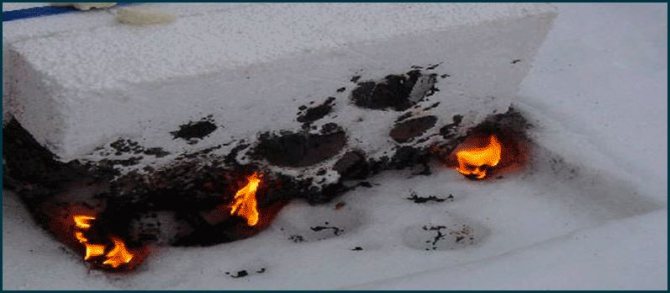

There is an opinion that the foam practically does not support combustion, which means that the house cannot flare up "like a match", I disagree with this and this is refuted by many photographs of houses engulfed in fire, I mean skyscrapers, one of these photos is at the beginning of this article ... Well, this is my opinion, you can agree with him or not, and we will continue.
Numerous tests carried out with foam lead to the following conclusions:
- the foam has the property of self-extinguishing, which means that in the absence of a constant source of flame it will not burn;
- most types of foam, during combustion, are deformed only in the part where an open flame was exposed;
- has the ability to smolder, giving off poisonous smoke;
- the height of an open fire during combustion reaches a maximum in 3-5 seconds, and then the process of smoldering and self-extinguishing begins.
Flammability class
The production of heat-resistant polystyrene foam is more expensive, the products are more expensive. The more perfect the modified technology, the lower the flammability of the resulting expanded polystyrene. All characteristics of non-combustible material must be indicated in the certificate.
Some suppliers of expanded polystyrene claim exceptional heat resistance, the foam polymer belongs to flammability classes G1 or G2. This is controversial information, often based on outdated flammability testing.
According to stricter government requirements, the first two flammability classes can only include products that do not form splashing drops. Expanded polystyrene, which is called non-combustible, does not possess such properties.
Suppliers often show video footage of a sample of non-combustible insulation suspended in the air being set on fire. In this position, drops of expanded polystyrene fall down, really, they do not splatter.
A completely different picture will be observed when igniting a sample lying on an incombustible substrate. Such frames are not often shown, because sparks flying off in different directions from the focus lead to the fire in the end of the entire sample of expanded polystyrene. Non-flammable properties are not confirmed by video recording.
Perhaps some manufacturers modify the technology for producing expanded polystyrene, saturating it with fire retardants to the level of incombustibility of class G2. This is reflected in the product labeling, technical recommendations for use. It is worth remembering that modern methods do not allow to obtain completely non-combustible polystyrene foam.
Polyurethane
The closest neighbor in the rating of heaters is polyurethane foam, made of different monomers: isocyanate and polyhydric alcohol.
Unlike non-combustible polymerized styrene, polyurethane contains nitrogen. Theoretically, this fact allows us to speak of its greater thermal stability. When monomers are combined under the action of water, carbon dioxide is released. It has absolutely non-flammable properties.
The volume of gas in rigid types of polyurethane foam reaches 90%. The material is very lightweight, much more heat-resistant than foam.
Non-flammable properties are enhanced by adding flame retardants to the alcohol component. Currently, this component is required in the production of insulation. Information about the belonging of products made of foamed polyurethane to class G2, especially to G3, can be trusted.
Application
Thermal insulation of buildings with foamed polymers is a good economic solution to energy conservation issues. The installation of an outer polymer layer significantly reduces heat loss.
In our country, this is relevant in almost all regions. The materials have gained particular popularity in areas of harsh climates. When buying products, you need to carefully study the certificates, pay attention to the instructions regarding the location of the insulation.
Some materials are intended for installation on plinths and foundations only. It is necessary to find out the possible atmospheric, mechanical loads; recommended installation technique.
Analyzing information about all types of expanded polystyrene and other foamed polymers, you can make the right choice and ensure maximum safety.


